Total population in Siquijor comprises 1.3 percent of the total population of Central Visayas
As of 01 May 2020, Region VII has a total population of 8,081,988 persons while Siquijor has a total count of 103,395 persons, which shares 1.3 percent to Central Visayas. The household population and number of households of the province reached a total of 103,014 and 25,805, respectively. (Table A.)
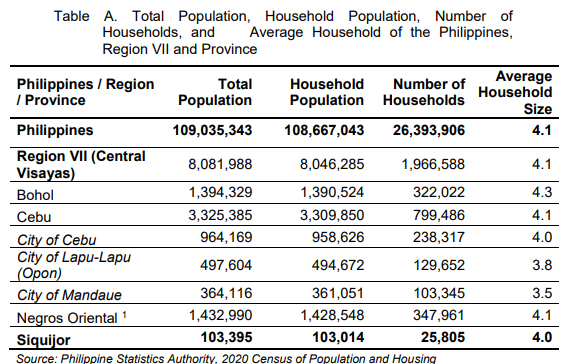
Included in the total population of Siquijor is the institutional population with a total count of 381 persons. These are the persons residing in collective or institutional living quarters such as hospitals, orphanages, military camps, homes for the aged, jails and others.
Household population in Siquijor increased by 8.0 percent from its household population in 2015
Household population of Siquijor increased by 8.0 percent or 7,654 persons from 2015 mid-decade census. Conversely, with an increase of 2,922 households from the 22,883 households in 2015 Census of Population (POPCEN), and an increase of 4,594 households from the 21,211 in 2010 Census of Population and Housing (CPH). (Figure 1 and Table B.)
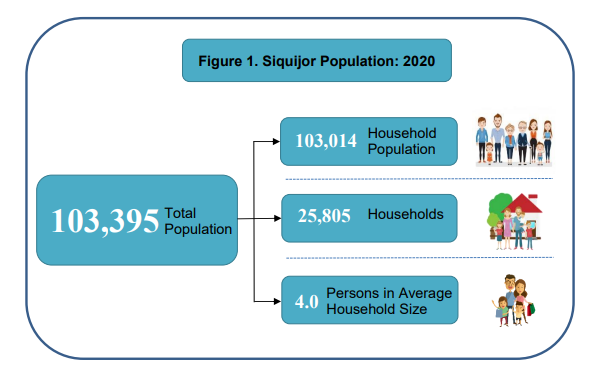
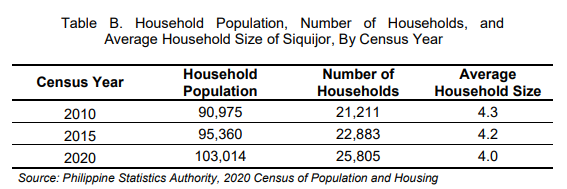
Fifty (50) percent of the total households in Siquijor are concentrated in the municipality of Lazi and Siquijor.
Among the six (6) municipalities of Siquijor Province, the municipality of Siquijor has the highest number of households in 2020 with 7,358. It is followed by the municipality of Lazi (5,564), municipality of San Juan (4,230), municipality of Maria (3,545), and municipality of Larena with 3,365 households. Meanwhile, the least number of households counted is in the municipality of Enrique Villanueva with 1,653. (Table C.).
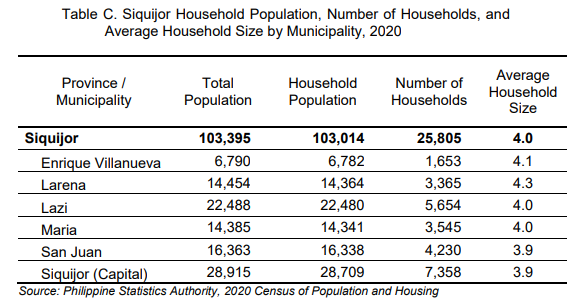
Average household size in the province declines to 4.0 persons in 2020.
Average household size in the province declined to 4.0 persons compared to the average household size of 4.2 in 2015 and of 4.3 in 2010. (Figure 2).
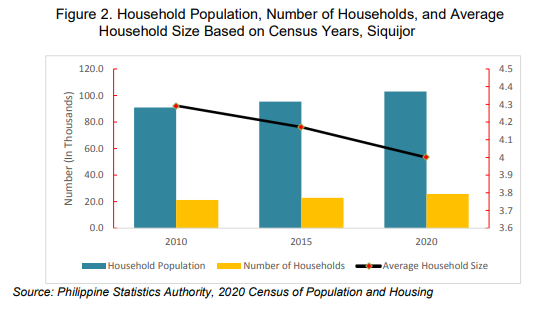
Table C showed that among local government units (LGU), the municipality of Larena has the highest average household size of 4.3, followed by municipality of Enrique Villanueva (4.1). While, Lazi and Maria has the same average household size of 4.0. On the other hand, municipality of San Juan and Siquijor (Capital) has the least household size on the average of 3.9.
TECHNICAL NOTES
The 2020 CPH was undertaken by the Philippine Statistics Authority in September 2020 pursuant to Republic Act No. 10625, also known as the Philippine Statistical Act of 2013, and Batas Pambansa (B.P.) Bilang (Blg.) 72, which further accorded the PSA the authority to conduct population censuses every ten (10) years beginning in 1980. The 2020 CPH is the country’s 15th Census of Population and 7th Census of Housing since 1903.
Information on the count of population were collected on its census reference time and date at 12:01 A.M. of May 1, 2020.
His Excellency President Rodrigo R. Duterte declared as official for all purposes the population counts by province, city/municipality, and barangay, based on the 2020 CPH under Proclamation No. 1179, dated 06 July 2021. The population counts were based on census questionnaires accomplished by about 90,000 enumerators deployed during the nationwide census taking.
The successful completion of the census-taking was made possible with the support of the local and national officials, government agencies, local government units, media, private agencies, and non-government organizations.
DEFINITION OF CENSUS TERMS AND CONCEPTS
Household
A social unit consisting of a person living alone or a group of persons who sleep in the same housing unit and have a common arrangement in the preparation and consumption of food.
Household Population
Comprises of persons who belong to a household.
Household Members
In determining household membership, the basic criterion is the usual place of residence or the place where the person usually resides. This may be same or different from the place where he/she is at the time of the census.
Institutional Living Quarters
Institutional living quarter (ILQ) is a structurally separate and independent place of abode intended for habitation by large groups of individuals. Usually has certain common facilities such as kitchen and dining room, toilet and bath, and lounging area that are shared by the occupants.
Institutional Population
Comprises of persons who are living in institutional living quarters. They may have their own families or households elsewhere but at the time of the census, they are committed or confined in institutions, or they are live in institutional living quarters and are usually subject to a common authority or management, or bound by either a common public objective or a common personal interest.
(SGD.) AURELIA M. CANDA
Chief Statistical Specialist

